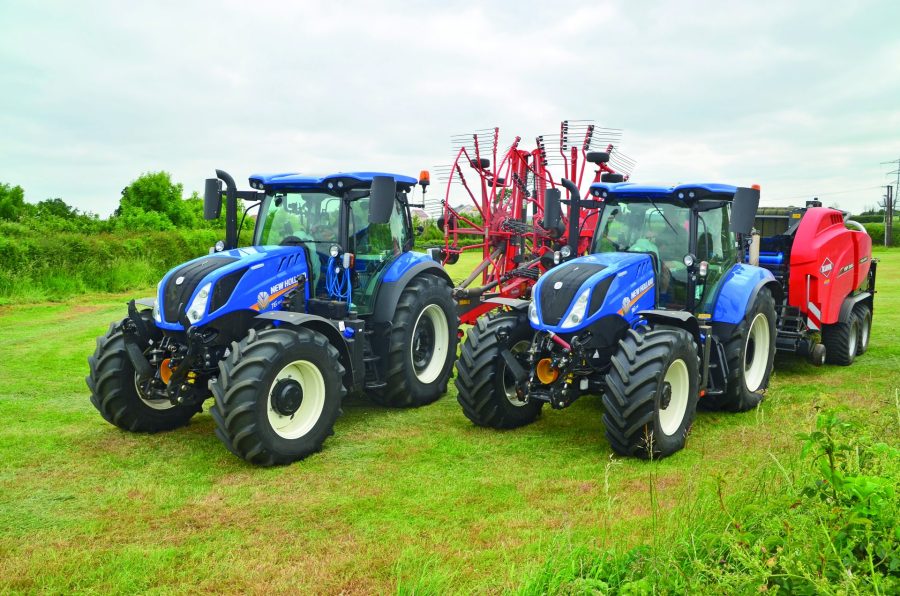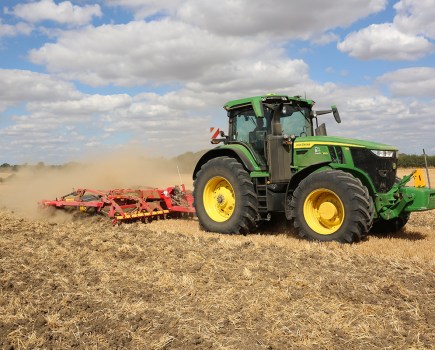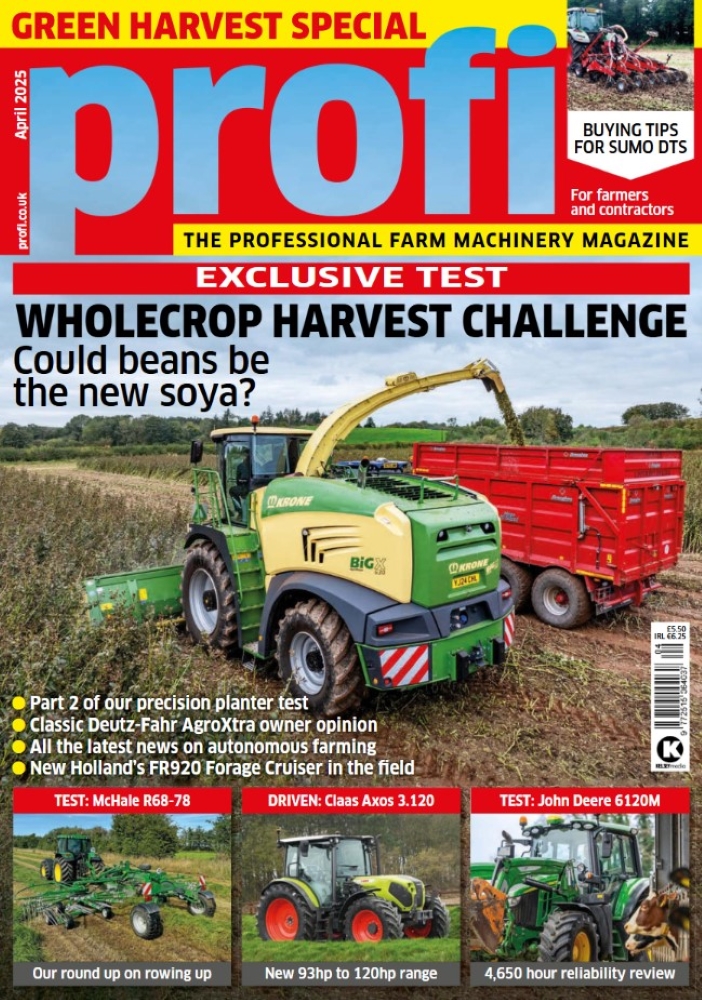REPORT: Engine re-maps and AdBlue deletes have improved reliability and overall machine efficiency for one Somerset New Holland operator. It’s hoped lower revving engines and smoother shifting gearboxes will inject some extra longevity for this tuned-up fleet.
Getting extra power out of an engine is nothing new, whether it’s 1980s-style tweaked pumps and turbos or modern-day re-mapped fuelling computers. While it’s doesn’t tend to be in manufacturers’ top ten favourite topics of conversation, re-mapping is becoming increasingly widespread – and not just on tractors outside warranty.
Somerset father-and-son team Danny and George Baker are big believers in the benefits of re-mapping and have employed the services of Avon Tuning to deal with some eight tractors over the last four years.
“Until last year I was involved in a specialist forage business – Country Haylage – and between that and the home farm we were running a fleet of over ten tractors – all New Holland T5s, T6s and T7s,” explains George. “In 2019 we took delivery of three four-cylinder T6.175s and were disappointed in their performance. We’d picked them for their short wheelbase, manoeuvrability and DynamicCommand powershift gearbox but to say they were flat as a pancake would be an understatement – when it came to low-end torque it was non-existent.”
Previous experience
Having had a Land Rover Discovery 5 re-mapped by Avon Tuning, he enquired as to whether the company could do a similar job on the business’ New Holland fleet. The answer was a resounding yes and a technician turned up in the field with some clever computer kit and set about altering the fuelling maps for the tractors to give them a bit of additional oomph.
But wasn’t all about more power for the sake of it or even fuel savings necessarily.
“As they came to us the T6.175s were pumping out a maximum of around 168hp. I wanted to be conservative to avoid doing any damage but also wanted a noticeable increase,” explains George. “We needed these four-cylinder tractors as small manoeuvrable machines for loader work but there is also the requirement to be capable of field work whether its mowing, ploughing or power-harrowing so we had them ramped up to 198hp.
“The engine isn’t working so hard and neither is whoever’s in the seat. You’re not constantly working up and down through the gears and the gear shifting seems significantly smoother when you do need to change both on the DynamicCommand and ElectroCommand boxes.
“For most jobs we’ll find that we’re now running a gear higher but with fewer revs. Obviously there is a fuel saving with lower engine rpm but its more about achieving more output without ranting the kit. By working it less hard we’re not punishing our machinery which we’re hoping will mean it’ll last longer. For around £700 a machine it’s worth every penny.”
AdBlue gets binned
But sadly that isn’t always the case. While the Bakers’ 2012-plate T6.175 had proved a dependable performer for a few years, when it reached somewhere around the 2,500-hour mark its AdBlue exhaust after-treatment started to give trouble. No small job to rectify, a complete new system was required with parts alone coming in at over £2,000.
Unprepared to shell out on something that would do nothing to improve the performance of the tractor, they mentioned the problem to Avon Tuning. The solution came in an ‘AdBlue delete’ software patch which effectively tells the engine management computer that it doesn’t need to de-rate when the tank is empty.
“Overnight we did away with our AdBlue issues on that tractor and from that day onwards the minute a new tractor arrives with us it is booked in for re-mapping and an AdBlue delete,” says Danny. “Not only do we finally get back bomb-proof blue tractors but we’ve got smoother running, lower revving machines.”
Rev reduction
Pulling a plough or set of discs it’s now possible to run much closer to peak torque – 1,400-1,600rpm whereas before the engines were spinning at closer to 1,900rpm. Similarly, with rpm-dependent pto work like round-baling it’s now possible to run at 1,550rpm in 540 Eco rather than the 1,900rpm that was required to maintain steady shaft speed before.
“Having come away from the haylage business, we don’t have access to the larger T7s that we did before and so re-mapping is even more crucial. We need small tractors with the ability to do heavier work,” says George. “We’ve got a 5.0m power-harrow that used to get hitched up to the T7.270 but we’ve found the T6.180 handles it fine, running 75-100mm deep at 5-7km/hr.
“Being a six-cylinder it’s definitely got more low-end grunt than the four-pots and that’s something you can’t artificially create with re-mapping. That said, the T6.175s are definitely torquier as a result of their tune-up.”
In fact, the Baker’s one remaining four-cylinder T6.175 is pretty much compatible with the six-pots for most jobs – it’s only tasks like mowing and power-harrowing where its low-end muscle means they get chosen in preference.
Gearbox choice
Having had plenty of experience of four- and six-cylinder models of T5, T6 and T7 New Hollands over the last 20 years, the Bakers have also had the chance to put a number of the company’s different transmissions to the test.
Today they would always opt for the 24 forward, 24 reverse DynamicCommand dual clutch box. With its eight powershift steps and two powered range changes it’s felt to provide more than enough ratios to match the tasks required of it.
“To be honest I struggle to find any weakness in the DCT box. It’s smooth through the gears and quick to change range. The brake-to-neutral function is a real plus-point for the round baler and loader work,” points out George. “That said, we had an AutoCommand CVT T7 which was fantastic on the six-string square baler we used to run with Country Haylage. The ability to set an exact ground speed meant you always got consistent flake counts and you could just feather it to match what was in front of you but it was noisier than the DCT.
“But it’s not as noisy as the ElectroCommand transmission. We have specced that in various tractors ever since having it in the TS115. It’s cheaper than anything else and far better to operate than the old PowerCommand. Who ever thought just six reverse gears against 19 forwards ratios was a good idea? And that jump from 12th to 13th… Even though they were reliable we wouldn’t have another.”
Summary
Initially driven to re-mapping by some below average bottom end performance from New Holland’s biggest four cylinder tractors, Danny and George Baker quickly became convinced that the technique would bring benefits to the entire fleet.
More low-end grunt and a significant uplift in the pony-count under the hood immediately brought about an improvement in performance with the result that the tractors typically run in at least one ratio higher than before but a lower revs. While they can’t claim any tangible fuel benefits, the machines run smoother and it’s a less fatiguing experience for the operator not needing to shift up and down through the gears on jobs like bale carting.
With a move away from the haylage business to more straightforward beef, grass and arable work New Holland’s heavier T7 prime movers are no longer required on the fleet. Surprisingly the significantly smaller T6s have stepped up to the plate and run the bigger than anticipated kit without fuss.





